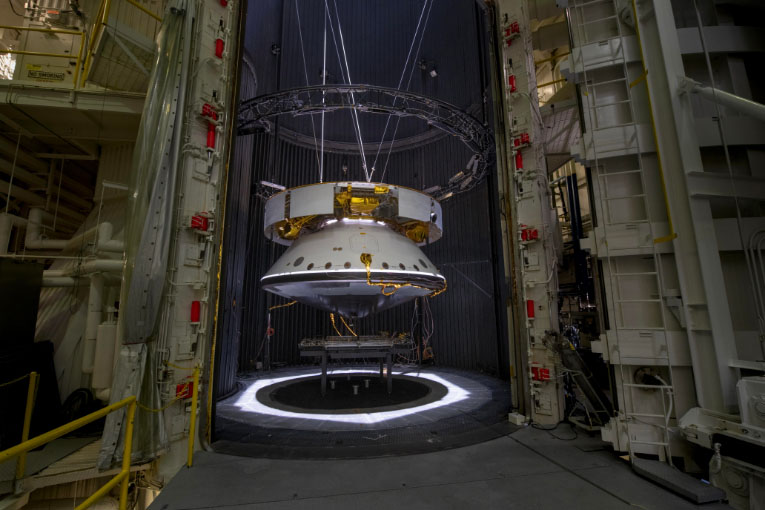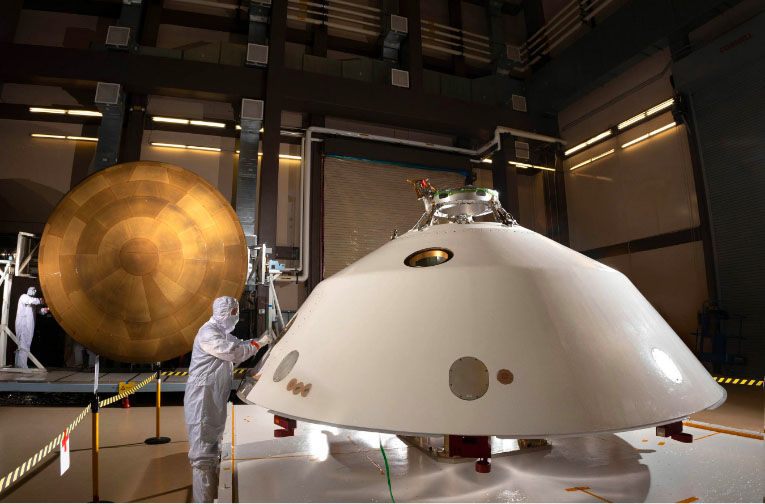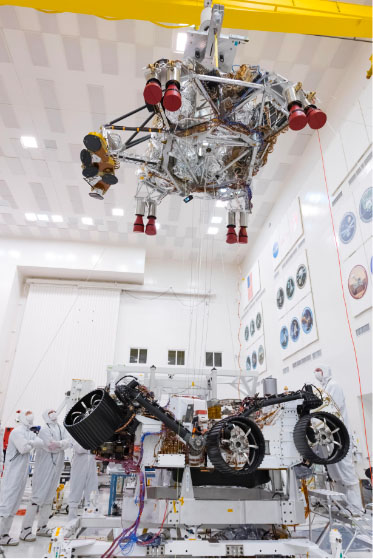Getting to Mars
Cruise Stage
 Image credit: NASA/JPL-Caltech | Full image and caption
Image credit: NASA/JPL-Caltech | Full image and caption
Perseverance is traveling to Mars in an almost identical way to NASA’s Curiosity rover, which landed in 2012. Three major components of the flight system will deliver the new rover safely to the surface of the Red Planet: the cruise stage, aeroshell, and descent stage.
After separating from the rocket, the ring-shaped cruise stage flies the aeroshell, and Perseverance within it, through interplanetary space to Mars. To remain stable throughout cruise, the combined spacecraft spins at about 2 rpm during the journey. The cruise stage features eight thrusters that receive commands to fire at specific times during the six-and-a-half-month journey to help shape the spacecraft’s trajectory to Mars (these are called trajectory correction maneuvers).
The cruise stage also has solar arrays that provide power in addition to the rover’s main power source, the Multi-Mission Radioisotope Thermoelectric Generator. And it is equipped with an assortment of antennas for communicating with Earth. Find more information in the Telecommunications section of this press kit.
Aeroshell
 Image credit: LMS | Full image and caption
Image credit: LMS | Full image and caption
This capsule protects the rover and descent stage as they plummet through the Martian atmosphere toward the surface of the Red Planet. Built by Lockheed Martin Space in Denver, the aeroshell has two parts: the bell-shaped back shell and, at its base, a heat shield. The heat shield is covered with tiles of a material called phenolic impregnated carbon ablator (PICA) that was invented at NASA’s Ames Research Center in California’s Silicon Valley. Engineers estimate the spacecraft could be exposed to temperatures as high as about 2,370 degrees Fahrenheit (about 1,300 degrees Celsius) from the friction generated as it descends through the Martian atmosphere. The job of the heat shield is to carry most of this heat away from the Perseverance rover.
The back shell contains several components critical to landing the rover: weights that alter the spacecraft’s center of mass so it can fly correctly, a parachute, and antennas both for communicating directly with Earth and for communicating with orbiters at Mars that can relay messages to Earth. In addition, the back shell and heat shield have a sensor suite known as the Mars Entry, Descent, and Landing Instrumentation 2 (MEDLI2). Since the back shell will also get hot – though not as hot as the heat shield – it, too, sports a protective covering, in this case made of a material known as SLA-561V.
Atmospheric friction will slow the entry vehicle to about 540 mph (865 kph) by the time it is about 7 miles (11 kilometers) in altitude above Mars. At around this point, the spacecraft will use a technique called Range Trigger, to determine whether it is in an optimal position relative to the landing target. If it is, the spacecraft will command the deployment of the parachute, which inherits its design from the Mars Viking missions of the 1970’s but is scaled up to 70.5 feet (21.5 meters) in diameter and strengthened to accommodate Perseverance’s greater mass.
As the parachute inflation slows Perseverance further, the heat shield will be jettisoned so that a radar and a new, specially developed Terrain-Relative Navigation system can help guide the rover to a safe landing in Jezero Crater.
The back shell with the parachute will separate from what is known as the powered descent vehicle (which includes the rover and the descent stage, a rocket-powered structure that helps the spacecraft land) about 60 seconds before touchdown.
The aeroshell also features the MEDLI2 sensor suite to collect data during EDL. More on this suite can be found in the Experimental Technologies section.
Descent Stage
 Image credit: NASA/JPL-Caltech | Full image and caption
Image credit: NASA/JPL-Caltech | Full image and caption
Think of the descent stage as a kind of jetpack with eight engines that safely lowers the spacecraft to the ground. The descent stage slows down until it’s hovering over the surface, then slowly winches Perseverance down with nylon cords as part of the sky crane maneuver.
When the rover is safely on the ground, pyrotechnically activated blades will cut the cords connecting it to the descent stage. The descent stage flies off to make its own uncontrolled landing on the surface a safe distance away from Perseverance.
More on Spacecraft
-

Perseverance Rover
Learn more about this part of the spacecraft
-

Getting to Mars
Learn more about this part of the spacecraft
-

Power
Learn more about this part of the spacecraft
-

Telecommunications
Learn more about this part of the spacecraft
-

Biological Cleanliness
Learn more about this part of the mission
-

Experimental Technologies
Learn more about these technologies



